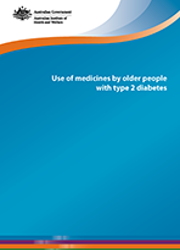Summary
This report examines the pharmacological management of type 2 diabetes in older Australians, using linked data from the Pharmaceutical Benefits Scheme and the National Diabetes Services Scheme. It explores, by age and time since diabetes diagnosis, supply patterns of blood glucose lowering medicines, blood pressure lowering and blood lipid modifying agents, and selected medicines for mental health and eye diseases. This study is limited to the specific cohort of people with type 2 diabetes who were aged 65 and over and who claimed their medicines or management products at a concessional rate in 2012.
This report fills an important information gap by documenting the supply patterns of glucose lowering medicines and medicines for associated conditions for an increasing older population with diagnosed type 2 diabetes. In this older population, the pharmacological treatment of type 2 diabetes is complex and challenging because of the need to weigh benefits and risks, due to high levels of comorbidities. The following findings were made within the population cohort in 2012:
Glucose lowering medicines
 The majority were supplied with glucose lowering medicines (85%), mostly metformin (69%), followed by sulfonylureas (40%).
The majority were supplied with glucose lowering medicines (85%), mostly metformin (69%), followed by sulfonylureas (40%).
 Metformin supply was lower for people aged 85 and over than for people in other age groups.
Metformin supply was lower for people aged 85 and over than for people in other age groups.
 One in 5 (20%) were supplied with insulin.
One in 5 (20%) were supplied with insulin.
 Two in 5 (40%) were supplied with medicines as monotherapy (that is, using a single medication), one-third (33%) were supplied with dual therapy and 11% with triple therapy.
Two in 5 (40%) were supplied with medicines as monotherapy (that is, using a single medication), one-third (33%) were supplied with dual therapy and 11% with triple therapy.
 Dual therapy and triple therapy were less common for people aged 85 and over, who were more likely to be supplied with monotherapy.
Dual therapy and triple therapy were less common for people aged 85 and over, who were more likely to be supplied with monotherapy.
Other medicines
 Seventy-seven per cent (77%) of the cohort were supplied with blood pressure lowering agents and 74% with lipid modifying agents. In total, 68% were supplied with both medicine types.
Seventy-seven per cent (77%) of the cohort were supplied with blood pressure lowering agents and 74% with lipid modifying agents. In total, 68% were supplied with both medicine types.
 Almost 1 in 4 (24%) were supplied with anti-depressants and 4% with anti-psychotics.
Almost 1 in 4 (24%) were supplied with anti-depressants and 4% with anti-psychotics.
Generally, it was found that the longer the time since diagnosis with type 2 diabetes, the more likely it was that an individual would be supplied with all medicine types and the more intense (that is, more dual or triple therapy) their glucose lowering treatment regimens would be.
This report highlights the complexity of pharmacological management in older people with type 2 diabetes and the diversity of medicine supply patterns in relation to age and time since diabetes diagnosis. However, the study has limitations, which should be taken into consideration when interpreting the results. Notably, the study is limited to an older concessional population and uses medicine prescription claims as a proxy for medicine use.



